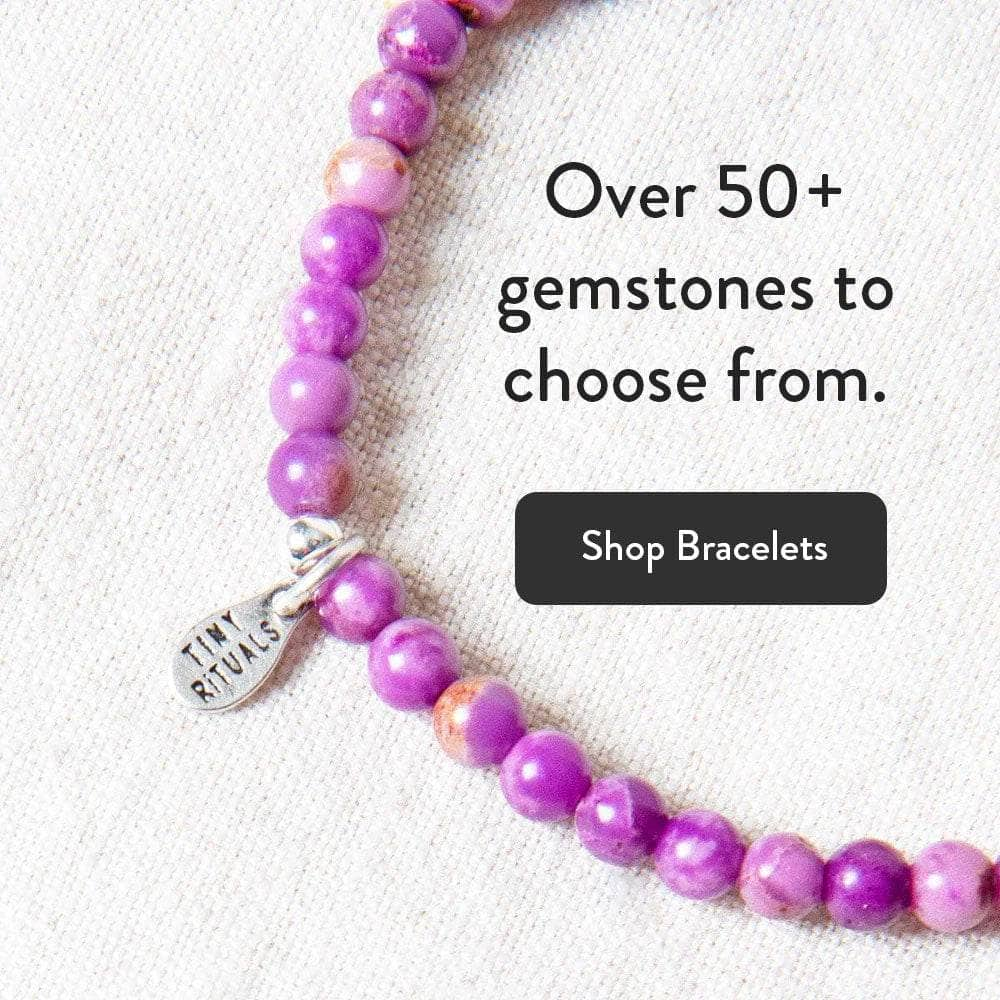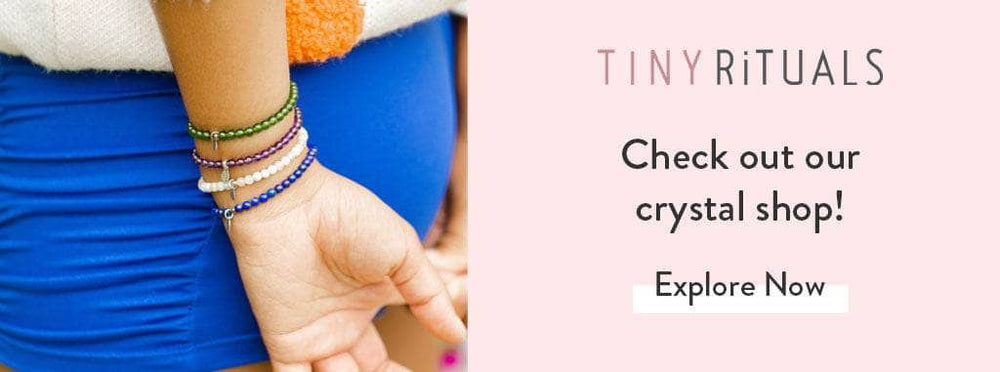
Check out our February Birthstone Necklace
Amethyst is the February birthstone known for its stunning purple colors, calming energy, and fascinating history. February is the month of purification. It comes after a period of long celebrations and is linked to the clever and assertive energy of Aquarius and the introspective and dreamy energy of Pisces. This puts a unique spin on the month of February. Historically, it has been seen as a month of spiritual purification, transition, and renewal as it marks the border between winter and spring in the Western hemisphere. This means that Amethyst suits it well, as this gem is also known for its qualities of calmness, clarity, and sweet sobriety. We take a deeper look at the purple hues of the February birthstone.
The Significance of February Birthstones
The February birthstone matches the February mood. February has many qualities as a month, and most are connected by the threads of moving into an introspective period and welcoming calm and stillness into your world so you can reflect before the business of spring. It's a time to call on the healing powers of harmony, embrace hope and optimism, renew intentions, and cultivate patience and resistance to get through that final stretch of the season.
The Lore of Amethyst

Check out our Amethyst Worry Stone
The Amethyst crystal has a long healing history, and the lore of its story dates back to Ancient Greek times. In Greek mythology, it was believed that Amethyst took its color purple from the tears of Dionysus. The story goes that when the God was drunk, they tried to ensnare a young maiden. The young maiden cried out to the Goddess Diana to help her, and she was turned into a statue of quartz. Dionysus, on realizing what he had done, shed wine-soaked tears in remorse, and as they fell on the statue, they turned the quartz to Amethyst. To the Ancient Romans, the Amethyst was also associated with Bacchus - the God of Wine and this gem was believed to protect against intoxication and keep you sound of mind and clear in wit.
Color and Characteristics
One of the most alluring elements of Amethyst is its stunning shades. From the palest breath of lilac to electric purple and deep reddish-purple shades and dark Amethysts stained the color of blood wine, many different types of light and rich purple stones exist. When the precious gem is formed, amethyst takes on different hues due to the levels of iron and natural irradiation. It also has a unique characteristic called color zoning, where the stone has an uneven distribution of color, resulting in a dance of light and color bands forming on the surface. This is often down to the natural impurities in the quartz crystal and only adds to its unique allure. When heat-treated, Amethyst can change its violet color coat to a variety of colors, from deep purple to an orange color, green color, blue color or even share sunshine shades with citrine after being exposed to intense heat.
Amethyst Through the Ages

Check out our Amethyst Pyramids
Throughout history and since Ancient times, Amethyst has been a highly revered stone. Of course, the Ancient Greeks and the Ancient Romans celebrated Amrhyst as a stone that kept you clear of mind. In more recent history, Catherine the Great, the Empress of Russia, was smitten with the stunning Amethyst stone and even owned her famed Amethyst Regalia - which featured large Amethysts set among diamonds and gold, symbolizing her royal status and power on special occasions. The Duchess of Windsor, Wallis Simpson, was also a fashion icon during her time, and her striking Amethyst necklace became a piece that was synonymous with elevated regal style.
Amethyst has always been a highly prized gemstone and was on a similar status line to the likes of Ruby and Sapphire. However, a discovery of large Amethyst deposits in Brazil transformed this gem, making it a much more accessible stone for those drawn to this purple and powerful variety of quartz.
Global Sources of Amethyst
Amethysts come from around the world and can be found in Brazil, South America, Africa, and the United States. Brazil is known for having large geodes and gorgeous clusters. Gems from Zambia are also famed for their intense coloring and deep purple hues. The USA is known for producing Amethysts with a more reddish-purple hue and perhaps inclusions of Hematite.
Once upon a time, Russia was also known for being a place to source Amethyst, especially during the 18th and 19th centuries in the depths of the Ural Mountains. However, the Amethysts in this area have been in decline for decades. Russian Amethysts are still highly sought after by collectors.
Amethyst in Modern Jewelry

Amethyst is a timeless gem that takes its place in both antiquity and modernity. You can wear this popular gemstone daily and make the most of its claiming energy, purple quartz power, and the fact that it looks beautiful. Amethyst rings, Amethyst bead bracelets, Amethyst earrings, and Amethyst necklaces can all be worn in everyday wear. If you want a simpler design to wear daily, you can look for elegant gemstone bracelets, birthstone rings, or something that uses smaller or singular stones that won't look too flashy. You can also opt for statement pieces that have larger, more sizable Amethyst crystals that catch the eye.
When picking your Amethyst piece, you should never forget the three Cs: color, cut, and clarity. There are many shades of Amethyst, and you can choose the purple variety you like—remember, rich, vibrant purples may have a higher price tag. The cut of Amethyst will also enhance its sparkle, so look for stones that have a good relationship with the light, as this can be a marker of a good cut. Clarity also refers to Amethyst's brilliance and clear transparency. While inclusions are natural, a dull Amthyst may be less impressive than one with high clarity.
Caring for Amethyst
Amethyst is a hard stone, scoring a seven on the Mohs scale of hardness. However, this still means it needs to be handled with care, as you don't want to scratch or damage its surface. To care for your Amethyst, you should avoid wearing it when doing anything that could be considered abrasive. You should also avoid using ultrasonic cleaners and steam cleaners to clean this birthstone. Any jewelry pieces can be cleaned simply with mild soap and water before thoroughly drying and buffing.
One of Amethyst's most important care tips is to keep it away from prolonged exposure to heat and light. Amethyst can be sensitive to heat treatment, and this can cause it to change color. If you want to keep your Amethyst dark purple, store it in a cool, dark place when not wearing it.
The Enduring Appeal of Amethyst
Amethyst has enduring appeal even beyond its birthstone status. People tend to be drawn to this gem thanks to its rich hues but also as it exudes an energy of calmness, personal empowerment, and deep inner strength. Its regal history, intrinsic beauty, and mystical ability add to that appeal. Amethyst birthstone jewelry can be a gorgeous and thoughtful gift for those born beneath a February sun. Even beyond the birthdate, welcoming Amethyst into your life can bring the benefits of heightened psychic abilities, a richer sense of serenity, better sleep, and decreased anxiety and depression.
Incorporating February Birthstones into Your Life

There are many ways to welcome Amethyst into your life. One of the best ways to say yes to Amethyst is to choose to wear Amethyst jewelry. Having Amethyst against the skin can bring a calming presence to your day and also help you carry the intention of the gemstone energy with you. Amethyst drop earrings, Amethyst studs, Lavender Amethyst bracelets, and Amethyst anklets can all elevate your sense of style but also work in the way protective amulets do.
You can also bring Amethyst into your home by choosing decorative items made from Amethyst. Amethyst towers, Amethyst palm stones, worry stones, Amethyst cups, and Amethyst geodes can bring gentle, peaceful, and protective energy into your space. You can also use Amethyst crystals in your wellness practice, such as altar building, crystal grids, reiki and chakra cleansing, yoga, and meditation.
Caring for February Birthstones
Keep your Amethyst gemstones and jewelry pieces clean to keep them looking lush and their energy working to the best of their ability. As mentioned, avoid using steam cleaning or abrasive cleaning methods and stick to simple techniques of mild soap, soft sponges, and warm water. Keeping your gemstones charged is also important and you can use smudging, moonlight placement, soundbaths, and Selenite or Clear Quartz crystals to help elevate your Amethysts energy. Remember, keep your Amethyst away from high heat to ensure it doesn't shift shades.
Conclusion
Amethyst is a beautiful birthstone for February and matches its moods of being a stone that welcomes calmness and introspection so we can stay connected to our sense of self. Revered throughout history for being a stone that encourages clear thinking, the meaning of Amethyst never loses its potency, making it a perfect gem for daily wear.
FAQs
Why is amethyst February's birthstone
There are some theories about why Amethyst is the birthstone of February. One belief is that it was a stone worn by St Valentine. Another is that Amethyst has a calming energy, which matches the mood of coming from winter celebrations into a softer period before spring.
Which months have 2 birthstones
Those born in the months of March, June, August, October, November, and December will all have a choice of two brithstones or more.
What is the rarest birthstone
The red diamond is considered to be the rarest birthstone in the world. Diamonds are generally pricy birthstones, and Emeralds follow suit. It is believed that there are only 20-20 specimens of red diamonds in the world, which makes it such a rare gemstone.
Is amethyst a lucky stone
Amethyst is considered a lucky stone because it has high spiritual energy and can bring more happiness and harmony into your life. It is also known for being a serene stone that encourages calm and clear thinking, which can always lead to prosperity and personal power.














